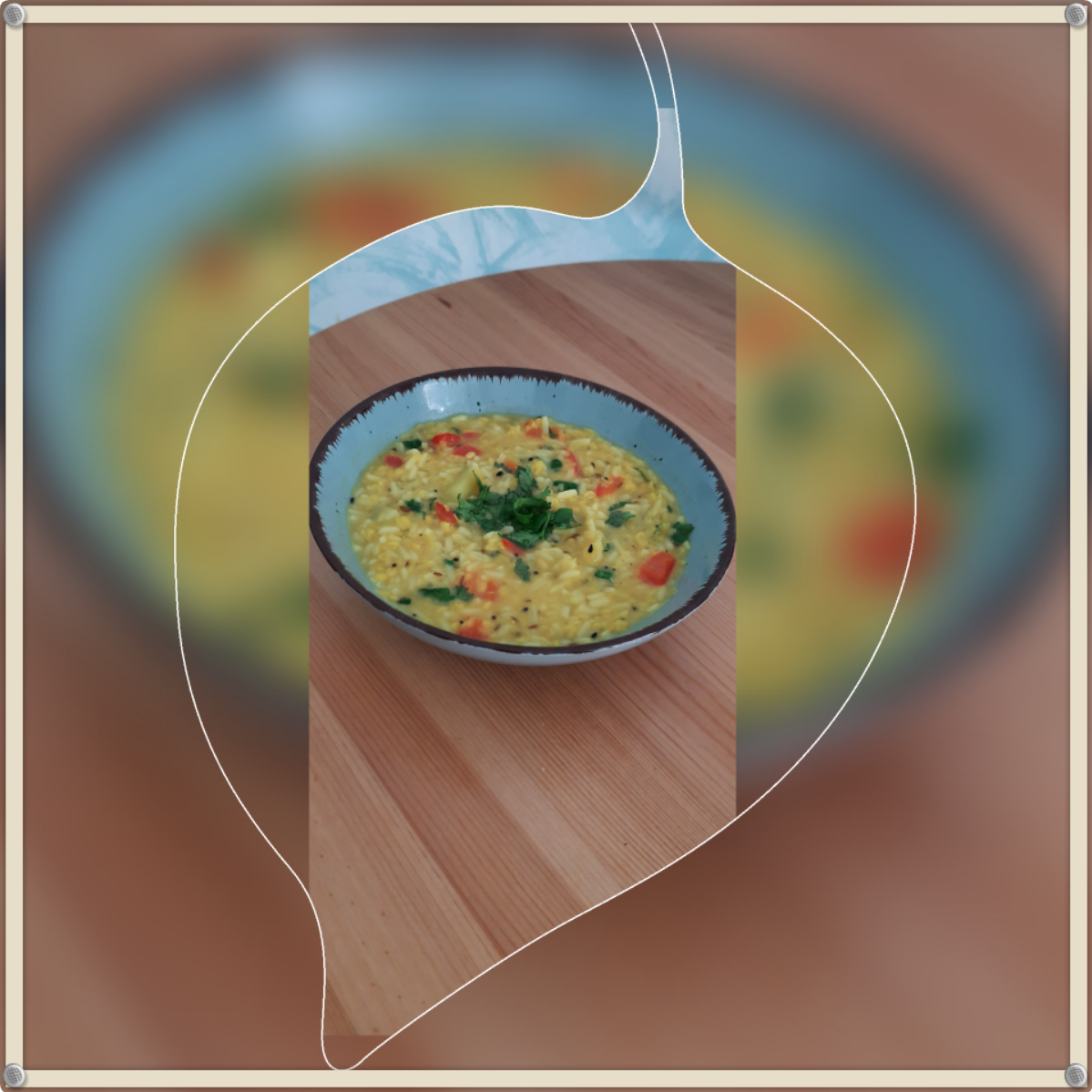Kitchari, a healthy and well established dish in Ayurvedic Cuisine

The translation of “Kitchari” (as well as Khichdi or Khichuri) is “Mixture”. In the classic version Kitchari contains yellow mung beans (hulled-split) and basmati rice, which are cooked together into a porridge.
Mung beans are used because they are not encreasing intestinal gas and bloating like other legumes since they are easier to digest and assimilate. They are a hig source of protein and fibre and they are packed with vitamins like A (beta-carotene), B1 (thiamin), B2 (riboflavin), B3 (niacin), B5 (pantothenic acid), B7 (biotin), B9 (folate), C (ascorbic acid), E (tocopherol), and K (coagulation). Furthermore mung beans contain minerals like calcium, potassium, sodium, magnesium and phosphorus.
Rice is a good source of carbohydrates. In addition it contains minerals like potassium, phosphorus, magnesium, calcium, copper, iron and zinc. The vitamines in rice are B1, B3 (niacin), B5 and E. Instead of rice one can also use quinoa or buckwheat, optionally vegetables can be added.
Kichari also contains spices like cumin, fennel and coriander which are tridoshic/able to balance all the three doshas. Means the doshas/bio-energies called Vata, Pitta and Kapha, which are responsible for physical, emotional and mental health, will be harmonized. Furtheremore these three spices are enhancing the digestion and releasing from intestinal gas.
Additionally tumeric/curcuma/haldi is used. It is tridoshic as well and contains active ingredients like curcumin. Amongst of many benefits the outstanding are it’s antioxidant, anti-inflammatory and anticancer properties, the ability to protect heart, liver and brain as well as the intestinal flora.
Another spice wich is used is asafetida/hing. It enhances Pitta, the thermogenic bio-energy, responsible for digestion, metabolism and sensation. On Vata and Kapha it has a balancing effect. Since it works digestive and deflating, it is used in all kind of dishes with beans and lentils as well as vegetable stews. Hing should be used always moderately.
A root which shall not be missed in any Kichari is ginger. It stimulates digestive and metabolic processes which are named “Agni” in Ayurveda. Moreover is ginger helping to release toxicity. Above all it helps breaking down proteins and rids of excess gas. (Note: For pregnant women it is better to avoid ginger. If there is a higher quantity of ginger consumted there is the risk of miscarriage.)
Furthermore you can add any other spices as well as herbs according taste and ayurvedamedical qualities to support the balance of your constitution.
During cooking either dry or fresh curry leaves can be used. They increase the Pitta dosha and pacify Vata and Kapha. Curry leaves are very rich on vitamin A, other vitamins are B, C and E. They are a natural source of iron and calcium. Furthermore curry leaves have anti-diabetic, antioxidant, antimicrobial, anti-inflamatory and hepatoprotective (capability to protect the liver from damage) properties.
Another choice could be to just add fresh herbs after the cooking prozess. Beneficial herbs would be cilantro, basil or parsley.
Cilantro is tridoshic. From the three doshas it is especially balancing Pitta. It assists with digestion, relieves intestinal gas and burns Ama/the residue and waste products. Cilantro stimulates the normal appetite and has anti- inflammatory properties. It can strengthen and cleans the liver. Furthermore it has anti – rheumatic and anti – arthritic properties. Cilantro contains the vitamins A, C, E, K and is rich on the minerals calcium, iron, magnesium and potassium. In addition trace elements like manganese, zinc, chrome and selenium are contained in this herb.
Parsley is rich on the mineral potassium, others are calcium and magnesium. The vitamins contained in this herb are C, A, E and B3. The trace elements are manganese, zinc, iron, copper, fluoride and iodine. Parsley improves digestion and detoxifys the body. Moreover balances parsley Vata and Kapha, but too much intake can increase Pitta.
Common Basil balances Vata and Kapha. It increases Pitta. Basil is carminative and reduces Ama. The herb has antioxidant, antibiotic and anticancer properties. Furthermore it supports cardiovascular health through reducing high blood pressure. It is high on fibre and contains vitamins like A, B9, B6, (pyridoxine), C, E, K. The minerals contained in basil are potassium, calcium, magnesium and maganese. Trace elements are iron, zinc, copper, folate and phosphorus.
(Note: If you are cooking for young children use less curry leaves. Basil would be a very mild choice for children. Nursing mom’s should avoid parsley since it can minimise the milk production.)
For the Ayurvedic Kichari, based on plant food, oils like sesame, coconut or canola oil can be used. They should be organic and used in a moderate way, especially if the main constitution is Kapha. Sesame oil can be used for people whose dominant dosha is Vata. For Kapha typs canola oil can be taken. And for people whose main constitution is Pitta, coconut oil can be used. If one is cooking for the whole family, where there are individuals of different constitutions, one can use these oils alternately and work especially with tridoshic spices and herbs. Moreover, before eating, the individual family members can add one to two spices or fresh herbs which are especially supporting their individual constitution.
Since Kichari is a nourishing and restorative food, it is used in Ayurveda as Mono Diet (Single Food – Diet) during cleansing times like during a pancha karma cure or for times of sickness. It is than a main food source because it helps remove toxins stored in bodily tissues and restores systemic balance. Moreover it provides substantial proteins. Beyond this it is a nourishing food, especially for children and elderly persons.
For preparation it is important to know that the water content of the Kichari should be higher if the Agni is weak.
Kitchari is prepared in many ways, here is one:
Ingredients
200g yellow mung beans (nicely washed and over night in water soaked)
100g basmati rice (washed and rinsed)
1 to max. 2 tsp. plant oil of choice
1 tsp. cumin seeds
1 tsp. fennel seeds
1 tsp. coriander powder
2 tsp. tumeric powder/tumeric root chopped or grated
2 tsp. ginger root, chopped or grated
3-4 fresh or dried curry leaves (optionally)
a bit of sea salt
1 pinch of black pepper
1 pinch asafetida
3/4 L water
1/2 organic lemon
1 handfull of fresh cilantro leaves (or any other herb of choice)
optionally vegetables of choice like:
1 medium sized carrot, 1/2 zucchini, 1/2 red capsicum, 1 handfull fresh and cut cauliflower, 1/4 fennel bulb, 1-2 handfull fresh baby spinach, 1 potato
You can choose around 3 vegetables.
(Note: 1 tomatoe could be used as well but if there is already any imbalance visible through health issues, tomatoe should be avoided according Ayurveda.)
Preparation
In a cooking pot warm up oil and add cumin as well as fennel seeds. Roast them a bit and put asafetida in. After a while ginger comes in, roast it a bit and add tumeric. If you want to use curry leaves you can put them in now. Subsequently the mung beans are put in. Stir everything and poor water into the pot. Now you can add black pepper and coriander powder as well. Than let everything cook for around 15 min. After this put the rice in and stir well. If you wish you can add vegetables after 5 min. Wait until everything is cooked smoothly, than you can put salt inside. (Don’t add salt in the beginning of the cooking prozess, it will hamper the beans to cook properly from inside.) Water can always be added if there is a need. In the end you can garnish with cilantro or any other herb of choice. Furthermore lemon can be sprinkled over the Kichari.
